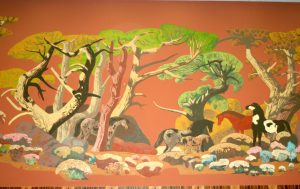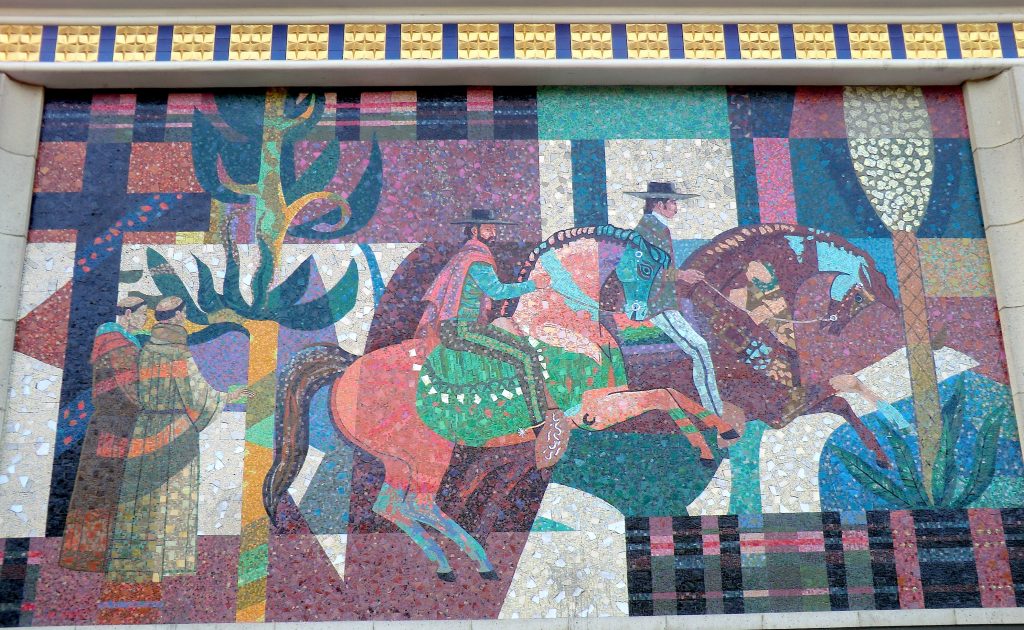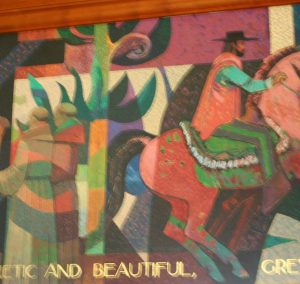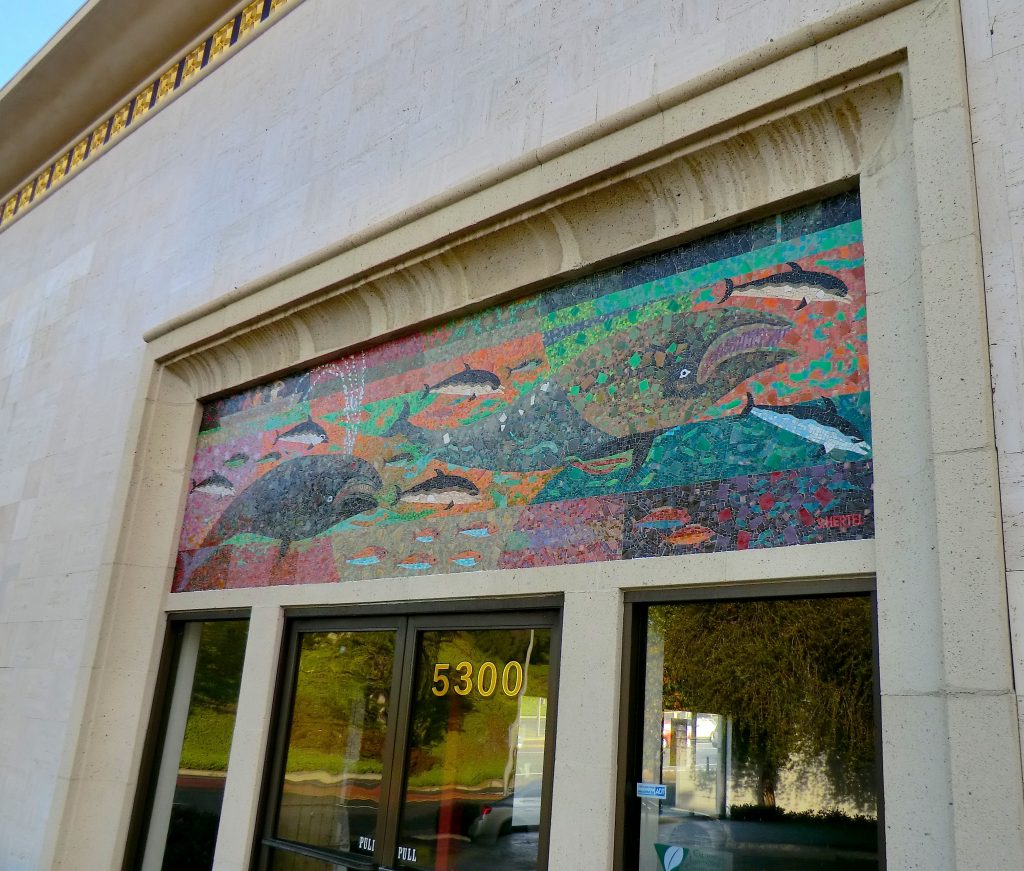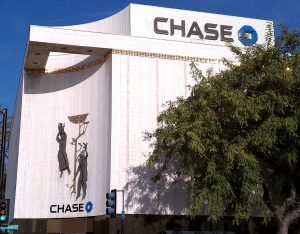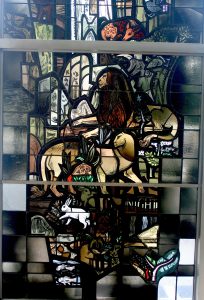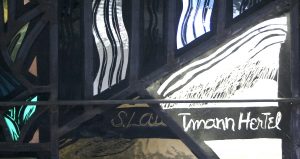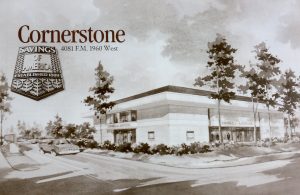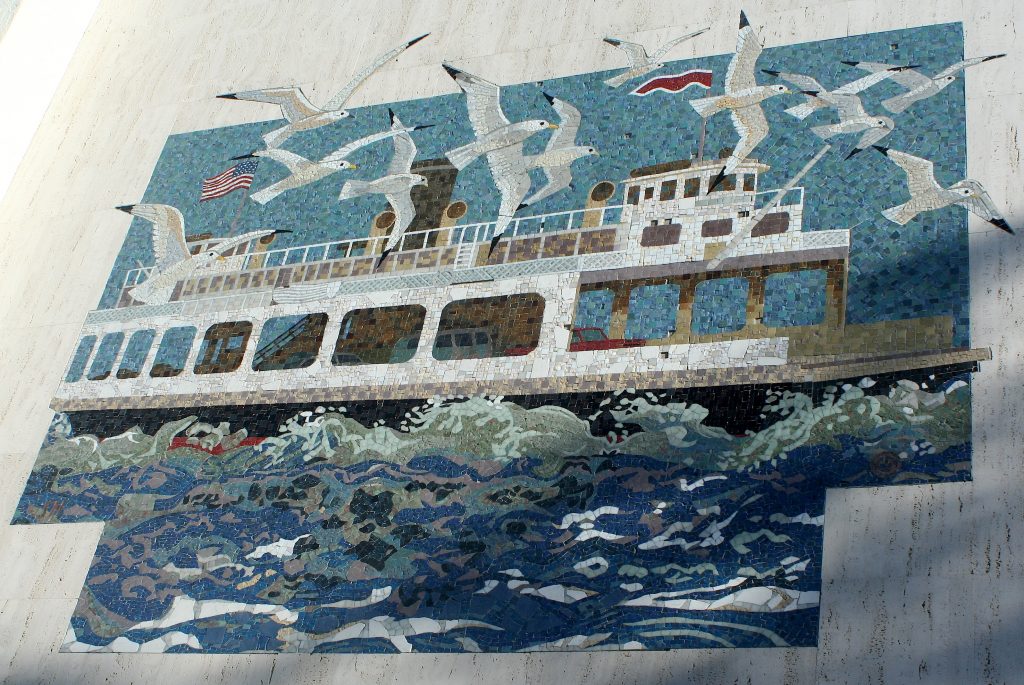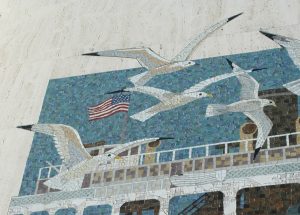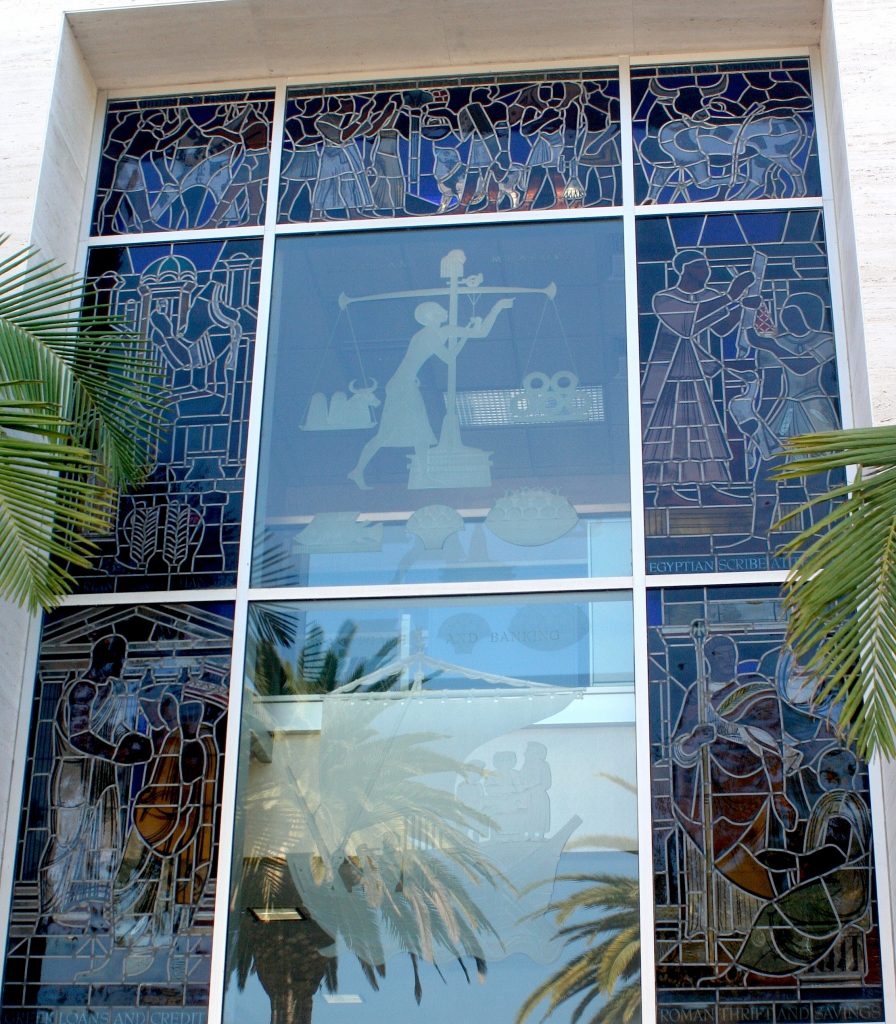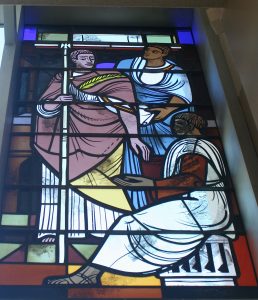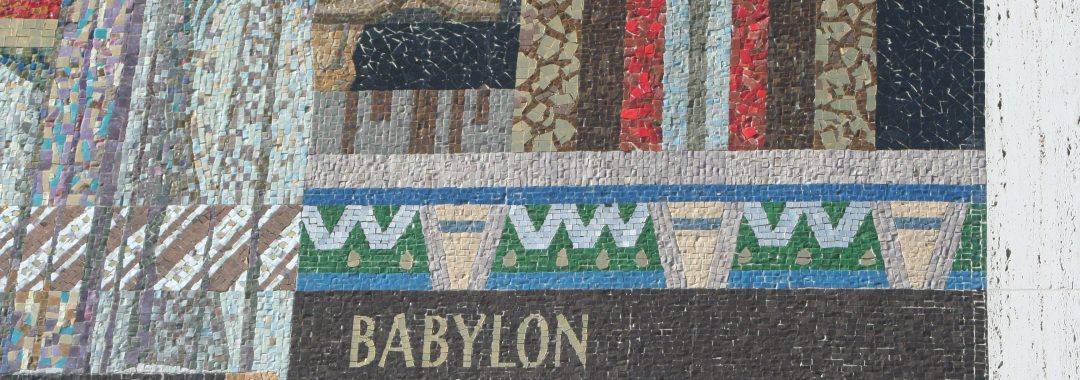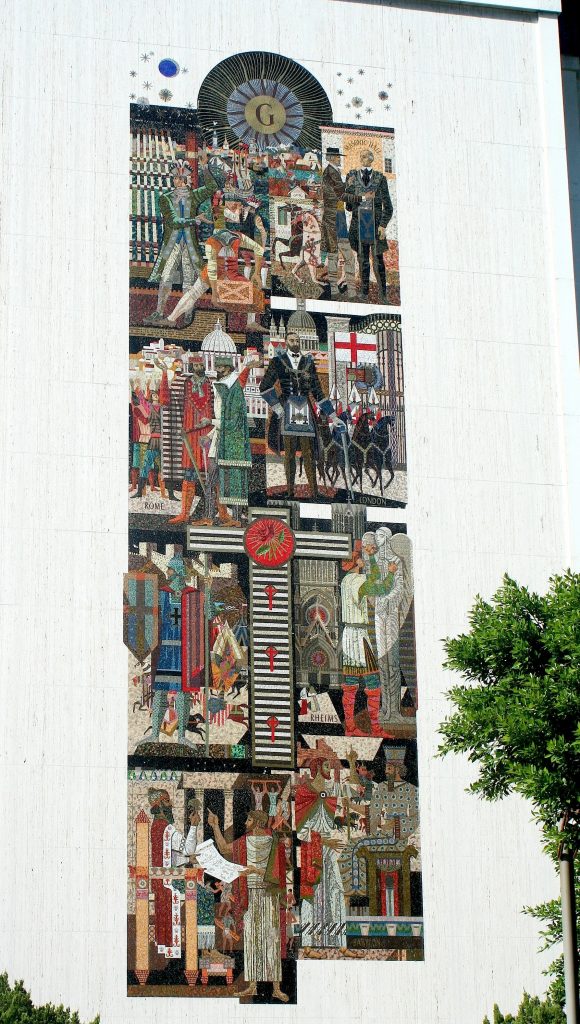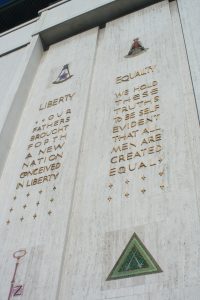Calling All Photos of Lost Sheets & Associates Bank Artwork!
(Sorry for missing last week; busy with book tour for The Great Heart of the Republic.)
Soon after the handover of Washington Mutual to Chase, Tony Sheets, Millard’s son, walked into the West Portal branch of the bank in San Francisco. After seeing the mosaic outside, showing the international reach of San Francisco’s trade, Tony proceeded inside and—found the interior mural painted over.
Now, the Home Savings banks saw a lot of remodeling between their construction and the present day—and, as we have seen, changes occurred under the management of Home Savings and Washington Mutual as well as Chase.
But given the greater press for uniformity from Chase, their efforts to paint walls white and put up Plexiglas shields has led to the greater threat to this artwork.
Finally, Tony Sheets and Chase have been working together to save more of this artwork – but that doesn’t tell us what has been lost.
The image above is from the corner of the West Portal mural, a casual shot I took back in August 2007. To the right is another painted mural from that branch, at the time; perhaps a local can tell me if it is gone as well.
But more than the specifics of these lost paintings, I want to use this as a general call for images of lost artwork—or, if you are not sure if the Home Savings artwork you pictured is lost, of all interior shots from these banks.
Brian Worley, who worked in the studio in the 1970s, got into the habit of taking installation shots of the mosaics, so we have an excellent record of the exterior artwork, from the first banks until the last mosaics completed. But, as he noted, “the painted murals were, as I remember it, installed later than the mosaic murals…The seams always needed to be touched up and that was done by Sue [Hertel], so I would have needed to go back later specifically to take pictures and was rarely if ever tasked with doing that. Same with the stained glass.” So the exteriors have a record; the interiors, less so.
Can you show us the lost artwork of Home Savings?
Pairs of Horsemen, La Mesa and San Francisco
As I mentioned last week, memories of my “home branch” in La Mesa are what motivated me to start this project. And I thought that all of the Home Savings branches held historic images, like this, showing the California past.
Well, last week’s whales, on the same branch, could have been my first clue that the larger study would do in a different direction. But I was still convinced that each branch received its own community-appropriate images, reflecting the specifics of local history and the local community.
Then I found these exact horsemen in the Lombard branch mural in San Francisco, and I could see how, when there were a lot of commissions due, the Sheets Studio could cut a few corners by duplicating the design.
Now, I still like the design, and I think that a portrayal of Californio horsemen (whatever the exact reference — the history throughout, I have learned, profits from vague referents) can fit for both locales and stories, showing the Spanish settlement of California.
The Lombard branch has a tremendous amount of art — a wraparound mural; stained glass; and a sophisticated look at the waterfront and how different cultures have used the San Francisco Bay — artwork intended for another branch in the area and moved to the Lombard exterior at the last minute.
Style is built of repeated elements (media, colors, topics), of course, and Home Savings sought a narrow enough range to make the banks instantly identifiable. And before the Internet age it was unlikely that viewers would have both of these images together.
But this is the most blatant repeat I have found; not just themes (as this shares with Laurel Canyon, for example) but the same figures, down to the colors of the saddles. The Franciscan friars (and the trees, front and back! and the background squares!) are there in both, too, marking how the missions opened up the possibility of ranching and other agricultural settlement among (or in place of) the Native Americans of the region.
In San Francisco, they have just been reversed –not a difficult process for the studio, when you consider that the mosaics are built on the image, enlarged and reversed. Their cowls and gestures — and the tree’s branches and colors, on both sides of the horsemen — are subject to the same doubling, almost identical to La Mesa. (If my photographs weren’t a bit blurry, who knows what other details might jump out.)
Are you aware of other exact copies, either of these figures or other Sheets Studio motifs? I will seek them out, as I continue my survey of the locations.
Whales at my former home branch in La Mesa
Happy Birthday, blog! Hard to believe, but one year ago, I put up the first list of these Home Savings banks, in my effort to draw attention to their history and to fight for their preservation.
A year later, I am gratified by the thousands of site visitors, and the contact from those who created the artwork, worked for Home Savings, lived with the artists, or simply always admired the Home Savings art and architecture. I have now conceived of a whole book project on this artwork, and 2011 is the year I can comprehensively research this art and argue more for its larger meaning.
In the meantime, I am back to the school year, teaching in Texas and having (at times quixotic) conversations with Chase Bank employees, many of whom know nothing about the artwork around them.
But, as today’s post shows, at least use as marquee banks by Chase can offer some security for the banks. This is my “home” branch, near the Grossmont Mall in La Mesa, just over the line from the neighborhood of San Diego where I grew up. The large horses on the front (come back next week) and this pod of whales is what stuck with me, making me want to do this project someday.
As you can see, the whales are signed by Sue Hertel, and something about those spouts always struck me as funny — these are whales having a good time, even just over a parking-lot door, far inland.
They were completed in 1976, just as burst of Home Savings banks were opening, all over California. And the Buffums department store used to anchor that Grossmont Mall, and my babysitter at the time (an Italian grandmother) used to take me to Buffums for lunch as a special outing.
She has passed away, and so has Buffums, and perhaps the place I went to driving school, up on the other mesa. And so has Home Savings, and so has Washington Mutual, who sold this branch in 1998. And so has the barbeques store that once was here. As reader Andrea Flint-Gogek so kindly shows us in these recent pictures, the former bank is empty.
So if you would love a classy location for your La Mesa business here it is! Save the whales! And if you are the owner and ever think of tearing it down, I can give you a list of museums that would be happy to pay the costs to remove such important mosaics from the buildings.
The Hidden LA Zoo Painting in Burbank
It seems like something out of a Dan Brown novel: there is a Sheets Studio painting, hiding in plain sight.
Last month I visited the Burbank Home Savings branch, and I could tell there was something fishy. On a prominent corner, the three-story structure dominates its site, with ornate sculptures high on the corner, and a mosaic of family life welcoming guests from up the hill.
Both works show family theme in full: a family reaching high into the tree, and children on the horses of a merry-go-round, a reference to the amusements of Griffith Park.
Though I could not find signatures, it looked like the work of Sue Hertel and perhaps Al Stewart, familiar Home Savings themes.
But it was when I went inside that I felt something missing. Like many former Home Savings banks, the large lobby had been subdivided into cubicles, and the balconies enclosed (in mismatching drywall). The travertine here was pinstriped with black lines, and a clock in the original was maintained, directly across from the teller’s windows, but it seemed like something was missing.
For such a large, prominent branch, no inside art?
Well, Carrie McCoy told me how things used to be. She had worked three decades for Home Savings, working her way up into the branch’s management, and still on hand when the sale to Washington Mutual occurred in 1998. And she had what seems to be the only photograph of the bank’s painting, of the LA Zoo, its angular trees and casual animals suggesting a collaboration between Millard Sheets and Sue Hertel. (No signature is evident in this photograph.)
And Carrie also knew what happened to it, and had the documentation to prove it. The LA Zoo painting was not destroyed; it was not removed, either. As far as she or I know, it remains in place, for in 1992 the Home Savings branch manager decided to cover it, in a renovation, and Carrie had copies of the specs from TG Construction of El Segundo, who did the work, from new paint and some window replacements to the order to “cover existing art work, approximately 24′ x 24′, at bank lobby area.” The plans show the drywall and studs used to protect it.
Those involved must have assumed this was their only choice, but as Tony Sheets has proven at the San Jose Airport Terminal and elsewhere, the paintings were almost always done on canvas, and hence they can be popped off the wall and rolled up, as needed.
Carrie said she mentioned this to the Washington Mutual, and then the Chase managers; perhaps this new announcement could get it uncovered, either for display in the bank, where it was intended, or at a nearby museum that also celebrates California and the West, Griffith Park, and the community — the Autry National Center.
*
Happy 2011! The definitive list of Sheets Studio public buildings is coming a bit slower than expected, but the addresses and status of the 200+ sites I have identified will be available in January.
Night and Day at Ahmanson’s “Other” Wilshire Bank
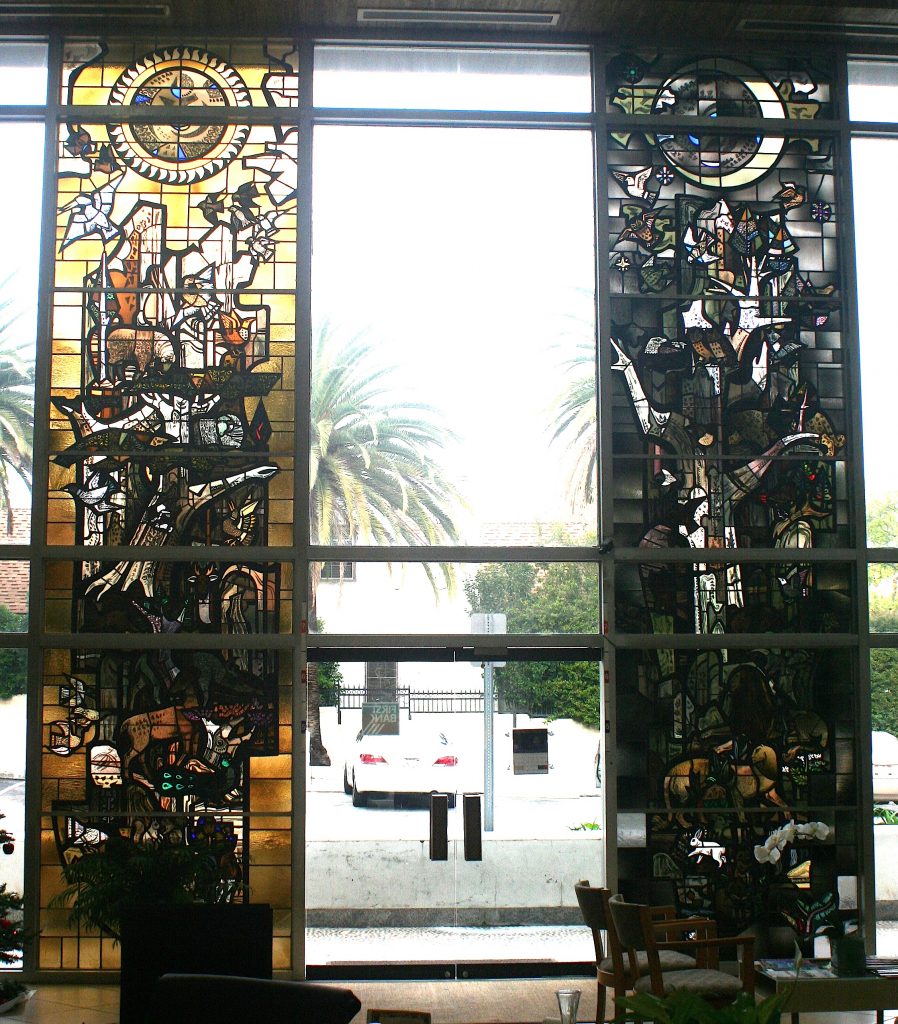
Susan Lautmann Hertel, “Day” and “Night” stained glass, fabricated by Wallis-Wiley Studio, Ahmanson Bank and Trust, 1959
The same day I visited the Wilshire Blvd. Scottish Rite Temple and the first Home Savings location at 9245 Wilshire, I made it down the block to the Ahmanson Bank and Trust location (now First Bank) at 9145 Wilshire. There is remarkable exterior art–mosaics and sculpture, soon to be restored–which I will describe another time, but this week I finally made it back with permissions to take photographs of these large stained glass windows.
The bank manager, Jeremy Sarkissian, is enthusiastic about this history of this bank, and he provided images of what once was — fountains, sculptures, and more. But the bank — with a wide opening entrance space, an unusual round elevator, and mosaic elements around the vault–still shows many signs of its Sheets Studio heritage, even before renovations.
These wonderful large stained-glass windows provide quite a contrast to the history of banking one block west. Filled with animals, gathered around a tree reaching up either to the sun or the moon, these windows show a vibrancy that hints at the choices that Sue Hertel made to enliven the projects with bright colors, a greater variety of animals, and a sensibility of animal arrangements and poses that suggest family intimacies, rather than static poses.
This project was documented while under construction by American Artist, showing most of the artists at work. And the signature–S. Lautmann Hertel–indicates a moment of transition in Sue Lautmann Hertel’s life, when, newly married, she was signing these works with both last names, before switching to Sue Hertel for the rest of her life.
In the past few weeks, I have had the chance to visit many new branches and museums; the results should be appearing in the months ahead. But for next week, I plan to offer a new definitive list of Sheets Studio projects in public buildings; check back for a New Year’s treat!
Rounding Up Artwork in Houston, Texas

Mailer for the opening of the Cornerstone branch, Houston, Texas, 1987; Denis O’Connor Collection, Huntington Library
Come on down for the Texas-size grand opening! “Savings of America” (one of the national names used, because Home Savings of America was taken in Texas) invites you to see the new artwork by “Southwestern artist Sue Hertel”! We are only twenty-two and a half years late — are we still eligible to win the Polaroid Sun 600 camera?
In these weeks when I am not commuting to Texas, I do find Texas popping up all over, including in the announcements for the Cornerstone branch, somewhere in the vast landscape of Houston.
As you can see, these later banks (in Texas, Florida, Illinois, and elsewhere) attempted to provide for the local community the sense of celebration and, at times. history that the original California branches did. Sue Hertel was living in Cerrillos, New Mexico, at this point, sending artwork back to Denis O’Connor in Claremont, so southwestern is probably an appropriate moniker as well.
This bank is still standing — take a look at the Google Streetscape image — and the expansion of Home Savings to Texas actually returned Sue and Denis to the state where some of the most magnificent early work of the Millard Sheets Studio, in the Mercantile National Bank of Dallas. A group of local preservationists and businessmen saved those images, finding a six-figure donation to pay for taking out the mosaics. You can read a bit about it here, but that will be a Texas-size effort to discuss another time.
Help Name the Details that Make Sheets Studio Banks Distinctive
It isn’t always as easy as this: “HS&L” icon tiles, original branch, 9245 Wilshire, Beverly Hills, 1955
O.K. lurkers, all of you who view the site but never write comments. I know you are out there — the website stats tell me so. Here is your opportunity for end-of-the-year redemption. And it won’t even require opening your wallet, like all those mailers and pledge drives.
Last week I had a chance to meet with Janet Hansen, Deputy Manager of the City of Los Angeles’s Office of Historic Resources. We discussed the progress of SurveyLA, a massive building survey out to find out what remarkable (or unremarkable) structures exist within the city boundaries–iconic office buildings, private homes, apartment-building types, gas stations, theaters, all of it.
She was aware of the Home Savings buildings, and we have discussed the existing lists of branches, either from the mid-1980s or today. But of course merely having been a Home Savings branch does not mean the bank location has (or even had) artwork. She asked me a question I want to start to answer here, with your help: What architectural details, colors, media, size, signatures, or other character-defining features make these Sheets Studio buildings special?
Some of the banks were conceived in their totality by the Sheets Studio; others merely received mosaics, murals, sculptures, and/or stained glass, attached to existing buildings. Some received only the projecting cornice and row of gold tiles around the top, and perhaps the travertine facing on the most public side — no real Sheets Studio work, other than to match the most basic elements of the more iconic designs.
Below is my list, roughly working from the most obvious to the more subtle.
What would you include? Once we have a good list, Janet can get it into the hands of the SurveyLA surveyors, and help to identify and preserve these buildings.
- Signatures/insignia from Millard Sheets (full name in almost all cases); Denis O’Connor (circle with CD inside, for DOC initials); Susan Lautmann Hertel (“SH” initials in most cases) on mosaics and murals
- Evidence the building was built between 1955 and 1998, and was used as a bank (first Home Savings, then most became Washington Mutual and then Chase)
- Totally-designed banks are squarish, 2-to-4-story buildings on prominent avenues (often corner lots), have large open spaces inside, originally built as “living-room”-style lobbies; sometimes soaring 2-story ceilings have been cut down by a drop ceiling of a new upper section
- They also tend to be set back a bit from the sidewalk, with room for sculptures, planters, and sometimes fountains; parking lot in the rear
- Mosaics, murals, and stained glass, marked by themes of California life, either contemporary or historic, and/or family life; often include horses, almost always figurative, not abstract
- Mosaics completed in Byzantine (not flat-square) tile, though at times with Italian (flat-square) tiles in background
- gold Lion of Venice, symbol of Home Savings, or large Home Savings shields (all removed now, I think)
- Travertine facing on all/most public faces of the building
- Projecting cornice and row of golden metallic tiles around the top of the facade (some have been repainted other colors, when no longer banks; some have brown bands, without tiles)
That is what I find to distinguish these buildings; anything I have missed?
The Late Work: Hertel and O’Connor and a Strange Bank Building in Coronado
On Thanksgiving Day, while my toddler napped, my father and I drove over the San Diego-Coronado Bay Bridge to take a look at the former Home Savings (and now, former Petco) at the center of the business strip on Orange Avenue in Coronado.
When I first heard that a former Home Savings had become a Petco, I couldn’t figure out how that could be; thinking about the kind of grand lobby in the original banks the Millard Sheets Studio designed for Howard Ahmanson, I could not figure out how that would work.
When I arrived to see this building, however, it made a bit more sense — in part because this was hardly a typical Home Savings building. It was a corner property on the main business thoroughfare, with a sizeable parking lot, but the site had been misused by those that built it; the corner was given over to parking, and the building — not, clearly, built as a bank originally — squeezed into a row of storefronts. It had been a not-very-prominent bank, then a too-small Petco; now it sits empty.
The artwork, which my files can date to 1985, is small, a modest addition to this preexisting building. But the work does hold some of the earlier themes — a joyous and iconic local experience, crossing the commuter ferry to San Diego — and a few seeming technical innovations.
As I noted a few weeks back, Alba Cisneros had described the difference between cutting the travertine around the small elements at the edges of a rectangular piece of artwork vs. finding ways to “cheat” it, by using broken travertine like mosaic pieces or simply staining/painting those edge details onto the building.
Despite the late date of this work, Hertel and O’Connor nevertheless were able to carefully cut the travertine to match up with the gulls’ wings, a few matching the rectilinear lines but the one at the center top bolding taking its mosaic wing at an angle, at great cost but greater beauty.
Even though the color palette of this mosaic is lesser — fewer offsetting Color Field-like choices — the craftsmanship on these tiles on planar surfaces — the sky, the rocks, the birds — seems unsurpassed, so dynamic and intricate, compared to some of the earlier compositions.
A nice sight to see over the holiday, and a nice reminder the questions of complexity, cost, theme and color do not simply rise and fall in the history of this artwork.
The First Home Savings: Stained-Glass Windows
Happy Thanksgiving Weekend!
While I am at home in San Diego, I thought it was worth going back to the original Home Savings and Loan bank. In the future, I will post more about the original Home Savings mosaic, and the iconic gold HS&L tiles that flanked the other artwork and ran beneath the windows on the bank.
But today I want to focus on what surprised me most when visiting the bank this month: the stained glass. I have written about the importance of stained glass at a number of marquee Home Savings locations, and I have found other inaccessible pieces of stained glass.
But the original branch held a double surprise for me: the answer to one riddle, and the beginning of the next .
First, the new riddle: why are so many of the stained-glass windows blocked off? This is somewhat an answerable riddle, by the simple fact that many of them, as here and at Laurel Canyon, reach the full height of the building, and so when renovations are made and second floors become inaccessible to the general public, the glass gets blocked off.
The image above tries to solve this problem by taking the external image–showing the full extent of the window–and reversing it; hence, if you go to see it, those captions will be only visible from inside.
The placement of the new stairway and drop ceiling on the inside make it impossible to see the captions, and I am pretty sure the clear, etched-glass sections are not original, and must replace either broken windows or windows that held Home Savings logos (more research awaits, as always).
But I knew there were captions, and I could make out what I was seeing here, thanks to an early image I saw at the Millard Sheets Studio in Claremont: a single panel of stained-glass work, showing the (Biblical?) scene of an Egyptian-dressed man carrying a calf over his shoulder, with the caption “banking.”
Clearly, this was artwork intended for another project that did not make it–but I also found it a fitting reminder within the Claremont studio of the primary client and benefactor, Howard Ahmanson and his banks. Given what Sheets says about his work on this first bank, I think this window could have gone all the way to fabrication before some design change meant it could not be installed in this bank as planned.
What to make of the imagery? Well, banking is an obvious subject for a bank, and the fine-art quality of these stained glass windows shows the initial desire to make these banks places to linger, to experience beauty. Such a universal history of banking hardly seems to engage the community and the location; of course, this was the first bank, and so those imperatives may not have been clear yet.
The Sheets Studio designed these windows but did not fabricate them; soldering and glass-cutting went on in Pasadena, though Katy Hertel remembers her mother going down to paint all the details onto the glass, so these works can clearly be considered as part of the overall Sheets Studio package. It is very hard to see enough detail here to really be sure, but these windows do not seem to share the style of the later Sheets Studio art–but neither, really, does the mosaic out front, which was fabricated in Italy. (More on all that in the weeks ahead.)
The placement of this window also indicates a pattern present here and at Laurel Canyon, and at Sunset and Vine: sculpture and mosaics in front, stained glass catching its light over the parking lot. That might have been about security for the artwork, but it also suggests the old cathedral trick of the rose window: catch them by surprise with the stained glass. You saw the mosaic out front, you pulled your finned car around to the back, you went in to bank, and then WHAM! on the way out, you look up to a beautiful image you are surprised not to have noticed before, over the door.
So many of these Home Savings banks have been remodeled, and the open doors have been changed, but it is worth considering how the art and architecture work together to create this spectacle.
Intricate Scottish Rite History on Wilshire
Last week, I was able to drive along Wilshire Boulevard and see my local string of Sheets Studio art: three banks and this monumental building, the four-story former Scottish Rite temple designed and decorated by the Sheets Studio in 1963.
The property is currently for sale; the Los Angeles Masons (Scottish Rite is one of the traditions of the Freemasons, a fraternal organization with many ties to the symbolism of the United States, as Nicholas Cage and Dan Brown remind us) lost a series of court cases over noise complaints and zoning for the building, and as of 2008 the California Supreme Court denied them the right to lease the property for commercial use.
The legal fight means that the building has been mostly closed since 1993, and completely closed since 2006, so I have not been able to see the Sheets Studio work inside the building (which I hear is extensive).
I provide here only a few examples of the sculpture and quotations from the building; following the tradition of Masonic structures such as the ornate George Washington National Masonic Memorial, built in 1932, that bridge the known history of the Masons (reaching back to the Enlightenment) with the order’s mythology, reaching back to the time of King Solomon’s Temple, with (as this mosaic and group of sculptures gives evidence to) detours into the law-giving and correct-living precepts of Hammurabi’s Code, a number of early Greek and Roman leaders, the builders of medieval cathedrals, Renaissance leaders, and finally American Founders. As anti-Masonic conspiracy theorists are quick to point out, the vast majority of U.S. Presidents have been Masons, along with other kinds of community leaders. But, without any internal knowledge, I have always seen that as a reflection of these individuals’ power, respect, acumen, and ability to network, rather than its cause.
From what I gather, the 1950s and 1960s was a high point for recent Masonic activity in the United States — a premier networking and campaigning venue, among an association of the established. And, as the later zoning fight about this building reveals, the prominent location on Wilshire, in what is otherwise a residential neighborhood, flanked with massive Protestant churches, indicates the influence of the Masonic group that built this structure.
Two elements of this mosaic interest me, the first being its deeply historical nature. Did this commission push the Sheets Studio toward using more history in the Home Savings banks? Next week I will discuss the first Home Savings location, also on Wilshire, that has a mix of historic and ahistorical imagery. Sheets spoke about how he had almost no guidance from Howard Ahmanson–simply a directive to make the art beautiful. Clearly the Masons had very specific ideas about who should be highlighted, what text should be included, and what gestures, symbols, and clothing would best express Masonic principles. I wonder if Sheets and his collaborators enjoyed the research project, and/or if the reception suggested more historical images would work well.
The other element is the mosaic’s style. Thanks to my experience with Alba Cisneros a few weeks ago, cutting tile and comparing Byzantine and Italian tile styles, I can recognize this Scottish Rite mosaic as a transitional moment. In his oral interview in the 1980s, Sheets discussed how the original mosaics were made in Italy, but that, given his disappointments with the results, he began to train himself and his studio in the creation of mosaics. This mosaic was made in California, but the signature technique — Byzantine tile, carefully cut and shaped — is not present throughout; there there are large sections of flat, square Italian-style tesserae, which are machine-made. Perhaps the sheet size of this four-foot mosaic is to blame, but I wonder if Sheets, Denis O’Connor, and others were still perfecting their mosaic tile. More interviews and more time in the archives will tell.

